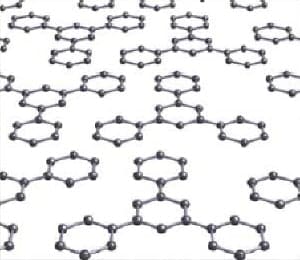Researchers in the US have made a novel chemical structure that has the largest internal surface area ever observed in an ordered material. Omar Yaghi at the University of Michigan and co-workers at Michigan and Arizona State University fabricated a new porous metal-organic framework with an estimated surface area of 4500 metres squared per gram - nearly 5 times larger than the previous record. The structure can bind large quantities of gas and could be used in a variety of applications including gas storage and catalysis (H Chae et al. 2004 Nature 427 523)

Porous materials with very large internal surface areas are important in many applications involving catalysis, chemical separation and gas storage. Until recently, the record for the largest surface area in an ordered structure was held by zeolite Y, one gram of which has a surface area of 904 metres squared. In 1999, however, Yaghi and co-workers discovered a class of structures called molecular organic frameworks (MOFs) that have surface areas of up to 3000 metres squared per gram. Now, the team has made a new crystalline MOF, which they have called MOF-177, with an even higher surface area.
To make their structure, Yaghi and colleagues mixed together a zinc nitrate compound with an organic material known as BTB – a molecule made up of four benzene rings arranged in a triangle (figure 1). They slowly heated the mixture to 100°C, held it at this temperature for 23 hours before cooling it back down to room temperature.
Using X-ray diffraction, the Michigan-Arizona team observed that the structure contained an open three-dimensional array of block-shaped crystals, in which zinc acetate clusters were linked to six BTB units (figure 2). Over 80% of the structure was made up of periodically spaced pores about 10 Angstroms across.
To test their structure’s ability to absorb gas, Yaghi and co-workers measured its uptake of nitrogen gas. They found that at relatively low pressures and a temperature of 78 Kelvin, MOF-177 absorbed nearly 1290 milligrams of nitrogen per gram of material. This result enable them to calculate that a gram of the material has a total surface area of 4500 metres squared.
The team now plans to show such absorption for other gases, such as hydrogen, with a view to making fuel cells from the material.




